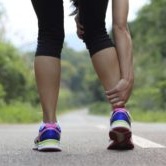
Each year 60% of runners are injured.
Most often, the pain is labeled an overuse injury.
Subsequently athletes experience localized weakness, altered movement patterns, and lost training days. More frustrating though is the fact that once a runner, or any athlete, returns to their training it is highly likely that the injury will happen again.
It is typically understood that overuse injuries occur due to too much training. Then why can many runners log in countless miles without getting injured? How do they do it? Why aren’t they getting over use injuries?
I believe it is because the injury in fact is not always due to over training, but actually under recovery.
How do we over train?
Exercise of any kind is a stimulus used to attain a certain response by our body. The workout actually causes slight damage, which is then repaired (hopefully) better and stronger than before. We spend a lot of time thinking about and planning our training program (the stimulus) for better performance. But a stimulus is only as good as the response that it causes. Or as good as the body’s ability to recover from and adapt to the activity.
The damaged structures need to be repaired to prevent more serious damage in subsequent training sessions. When a training regimen exceeds the rate that the body’s tissues can adapt injury occurs.
How do we under recover?
If there is no recovery, then there is no healthy adaptation to your body. If there is no change in your body, then there really is no reason to keep training. Adequate training recovery and adaptation is critical to seeing the gains and reaching the goals you set for your training program. If rate of recovery is improved, more frequent and higher intensity training is possible without the detrimental effects of over use injuries.
Just like prescribing a medication, a recovery plans dosage and frequency can not be arbitrary. It is dependent on the patient’s ability to adapt, age, general health, nutrition, and the training activity. It’s our job to provide the best environment for our body to recover and adapt.
Three aspects of a recovery centered program:
1. Mechanical
This includes your cardiovascular, nervous, and musculoskeletal system. . . probably the most obvious of the three. Your nervous systems is the “battery” that fires all your muscles and must be allowed to rest. The cardiovascular system pumps blood bringing oxygen and nutrients to the muscles while removing the waste products (ie lactic acid) that accumulate.
Massage can be a beneficial mechanical strategy to break up scar tissue, relax the nervous system, and improve blood flow, while decreasing muscle soreness. Our best tool to do this is Astym, which you can learn more about at www.astym.com.
2. Cognitive
This includes your brain, hormones, and immunity. Cognitive strategies are used to diminish the effects of stress hormones on the recovery process. Even work and life stress can prevent you from recovering adequately.
Your immune system is forced to respond with “fight” mechanisms that don’t allow training adaptations to occur. In fact, your body thinks it is still in training mode, not recovery mode. Anything to decrease the overall cognitive stress (including relaxation, meditation, yoga and the like) will assist the recovery process.
3. Nutritional
The way you fuel your body gives it the ability to adapt, repair, and remodel tissues. This includes protein for tissue repair and building muscle. Carbohydrates are needed to fuel the process and maintain the immune system. In addition, omega 3 fatty acids decrease inflammation and antioxidants help heal tissue.
Recovery Success!
Address these three areas to stay healthy, train hard, and rest well. In this way you can keep doing the activity you love without destroying your body in the process.
You may already be overwhelmed by your training schedule and don’t even want to think about a recovery plan. Worse off, the health and fitness world is a confusing place. But it doesn’t have to be. Let us help you make sense of it all.
Physical therapy can provide guidance for competent self care and health mentorship. We can guide you toward appropriate fitness nutrition and supplementation, as well as healthy training schedules. Have a chat with a Doctor of Physical Therapy Today for FREE to find out if your aches and pains are due to overuse or under recovery AND find your best solution. Click the link below to request a call.




